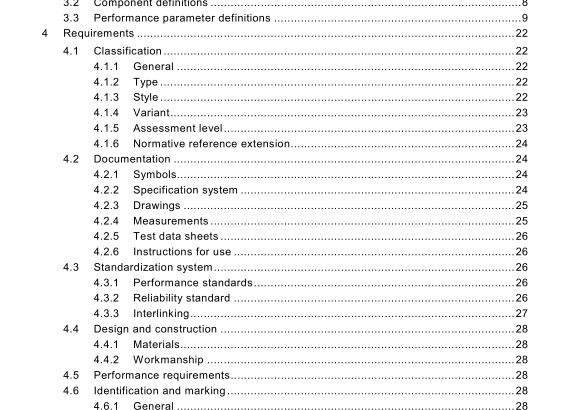IEC 62074-1:2009 pdf download – Fibre optic interconnecting devices and passive components – Fibre optic WDM devices – Part 1: Generic specification
4.2.4.2 Reference components
Reference components for measurement purposes, if required, shall be specified in the relevant specification.
4.2.4.3 Gauges
Gauges, if required, shall be specified in the relevant specification.
4.2.5 Test data sheets
Test data sheets shall be prepared for each test conducted as required by a relevant specification. The data sheets shall be included in the qualification report and in the periodic inspection report.
Data sheets shall contain the following information as a minimum:
• title of test and date;
• specimen description including the type of fibre and the variant identification number;
• test equipment used and date of latest calibration;
• all applicable test details;
• all measurement values and observations;
• sufficiently detailed documentation to provide traceable information for failure analysis.
4.2.6 Instructions for use
Instructions for use, when required, shall be given by the manufacturer.
4.3 Standardization system
4.3.1 Performance standards
Performance standards contain a series of set of tests and measurements (which may or may not be grouped into a specified schedule depending on the requirements of that standard) with clearly defined conditions, severities and pass/fall criteria. The tests are intended to be run on a “once-off” basis to prove any products ability to satisfy the “performance standards” requirement. Each performance standard has a different set of tests, and or severities (and or groupings) represents the requirements of a market sector, user group or system location. A product that has been shown to meet all the requirements of a performance standard can be declared as complying with a performance standard but should then be controlled by a quality assurance / quality conformance programme. A key point of the performance standards is the selection of test and severities from the tests and measurements standards, for application in conjunction with interface standards on inter product compatibility (this particularly relates to attenuation and return loss). Certainly conformance of each individual product to this standard will be ensured.
4.3.2 Reliability standard Reliability standards are intended to ensure that a component can meet performance specifications under stated conditions for a stated time period. For each type of component, the following need to be identified (and appear in the reliability standard):
• failure modes (observable general mechanical or optical effects of failure);
• failure mechanisms (general causes of failure, common to several components), and failure effects (detailed causes of failure, specific to component).
These are all related to environmental and material aspects.
Initially, just after component manufacture, there is an “infant mortality phase” during which many components would fail if they were deployed in the field. To avoid early field failure, all components may be subjected to screen process in the factory, involving environmental stresses that may be mechanical, thermal and humidity related. This is to induce known failure mechanisms in a controlled environmental situation to occur earlier than would normally be seen in the unscreened population. For those components that survive (and are then sold), there is a reduced failure rate since these mechanisms have been eliminated. Screening is an optional part of the manufacturing process, rather than a test method.
It will not affect the “useful life” of a component defined as the period during which it performs according to specifications. Eventually other failure mechanisms appear, and the failure rate increases beyond some defined threshold. At this point the useful life ends and the “wear-out region” begins, and the component must be replaced.
At the beginning of useful life, performance testing on a sampled population of components may be applied by the supplier, by the manufacturer, or by a third party. This is to ensure that the component meets performance specifications over the range of intended environments at this initial time. Reliability testing, on the other hand, is applied to ensure that the component meets performance specifications for at least a specified minimum useful lifetime or specified maximum failure rate. These tests are usually done by utilising the performance testing, but increasing duration and severity to accelerate the failure mechanisms. A reliability theory relates component reliability testing to component parameters and to lifetime or failure rate are under testing.
The theory then extrapolates these to lifetime or failure rate under less stressful service conditions. The reliability specifications include values of the component parameters needed to ensure the specified minimum lifetime or maximum failure rate in service.
4.3.3 Interlinking With regard to interface, performance and reliability standards, once all these three standards are in place, the matrix given in Table 2 demonstrates some of other options available for product standardisation.
